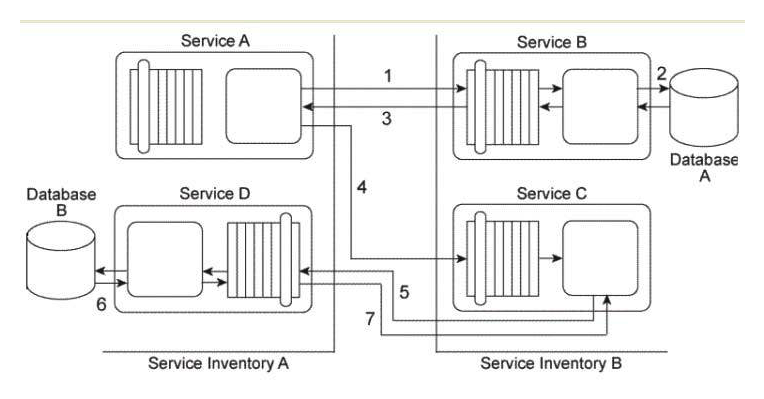Service Consumer A invokes Service A (1) . The logic within Service A is required to retrieve three independent data values from Services B, C, and D and to then return these data values back to Service Consumer A. To accomplish this, Service A begins by sending a request message to Service B (2) . After receiving a response message with the first data value from Service B, Service A sends a request message to Service C (3) . After it receives a response message with the second data value from Service C, Service A then sends a request message to Service D (4) . Upon receiving a response message with the third data value from Service D. Service A finally sends its own response message (containing all three collected data values) back to Service Consumer A. Service Consumer A and Service A reside in Service Inventory A. Service B and Service C reside in Service Inventory B. Service D is a public service that can be openly accessed via the World Wide Web. The service is also available for purchase so that it can be deployed independently within IT enterprises. Due to the rigorous application of the Service Abstraction principle within Service Inventory B, the only information that is made available about Service B and Service C are the published service contracts. For Service D, the service contract plus a Service Level Agreement (SLA) are made available. The SLA indicates that Service D has a planned outage every night from 11 PM to midnight.  You are an architect with a project team building services for Service Inventory A . You are told that the owners of Service Inventory A and Service Inventory B are not generally cooperative or communicative. Cross-inventory service composition is tolerated, but not directly supported. As a result, no SLAs for Service B and Service C are available and you have no knowledge about how available these services are. Based on the service contracts you can determine that the services in Service Inventory B use different data models and a different transport protocol than the services in Service Inventory A. Furthermore, recent testing results have shown that the performance of Service D is highly unpredictable due to the heavy amount of concurrent access it receives from service consumers from other organizations. You are also told that there is a concern about how long Service Consumer A will need to remain stateful while waiting for a response from Service A . What steps can be taken to solve these problems?
You are an architect with a project team building services for Service Inventory A . You are told that the owners of Service Inventory A and Service Inventory B are not generally cooperative or communicative. Cross-inventory service composition is tolerated, but not directly supported. As a result, no SLAs for Service B and Service C are available and you have no knowledge about how available these services are. Based on the service contracts you can determine that the services in Service Inventory B use different data models and a different transport protocol than the services in Service Inventory A. Furthermore, recent testing results have shown that the performance of Service D is highly unpredictable due to the heavy amount of concurrent access it receives from service consumers from other organizations. You are also told that there is a concern about how long Service Consumer A will need to remain stateful while waiting for a response from Service A . What steps can be taken to solve these problems?
Definitions:
Settling Point
A theory suggesting that weight tends to stabilize around a point at which there's a balance between energy intake and expenditure.
Serotonin
A neurotransmitter that plays a key role in regulating mood, appetite, and sleep, among other functions.
Universal
Refers to something that is applicable to all cases or situations, often without exceptions.
Excessively Salty
Describes food or water that contains a higher concentration of salt than is considered palatable or healthy.
Q15: Despite the best efforts to minimize the
Q26: I have a service that is required
Q30: You have created a custom report that
Q41: Which of the following will NOT generate
Q47: A _ establishes a common access point
Q54: A service contract publishes information that makes
Q61: The standardization of services within a service
Q80: Which of the following statements is true?<br>A)
Q91: Services are ideally designed to be:<br>A) agnostic
Q114: Fidelity bonds cover employees against dishonest acts